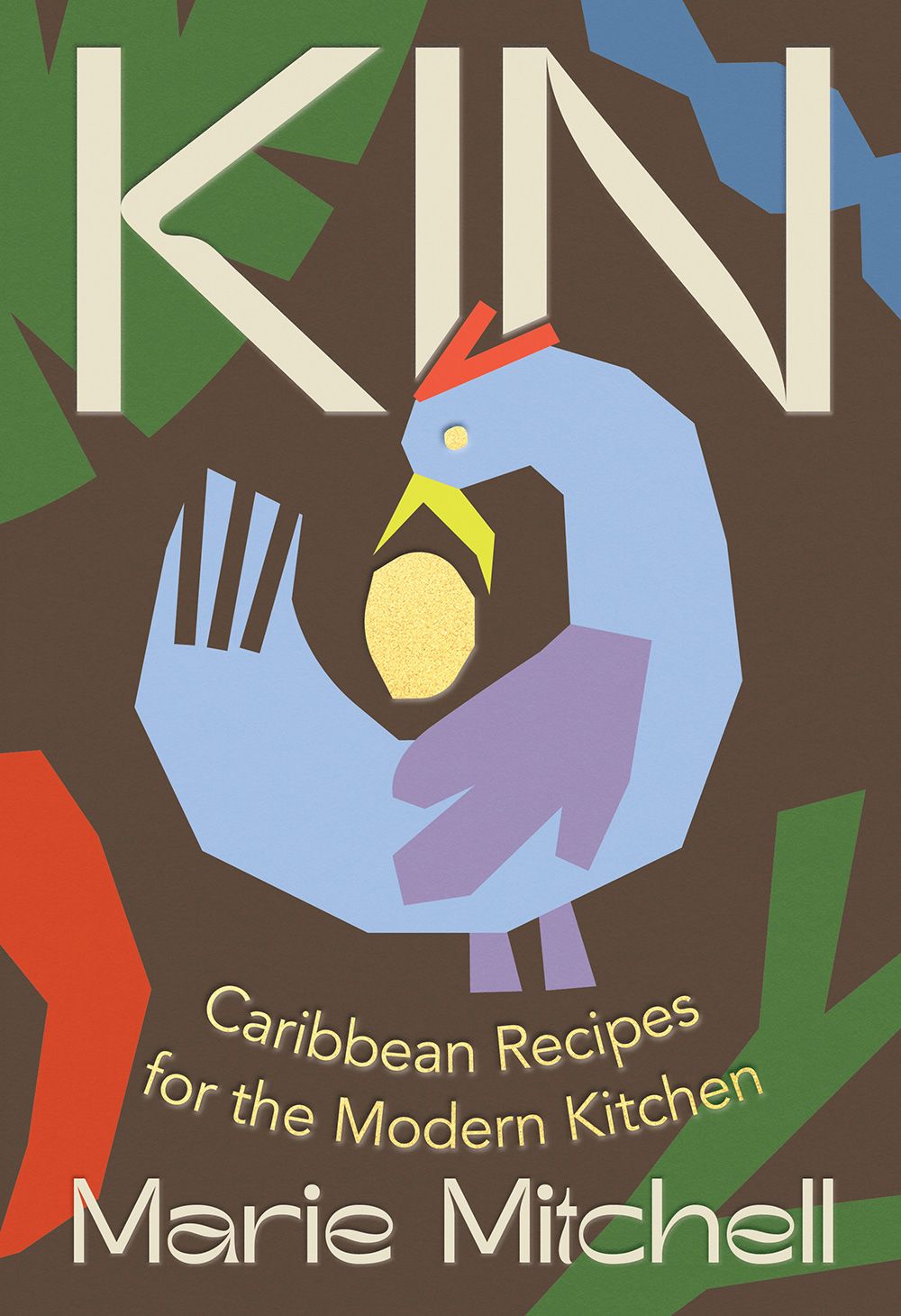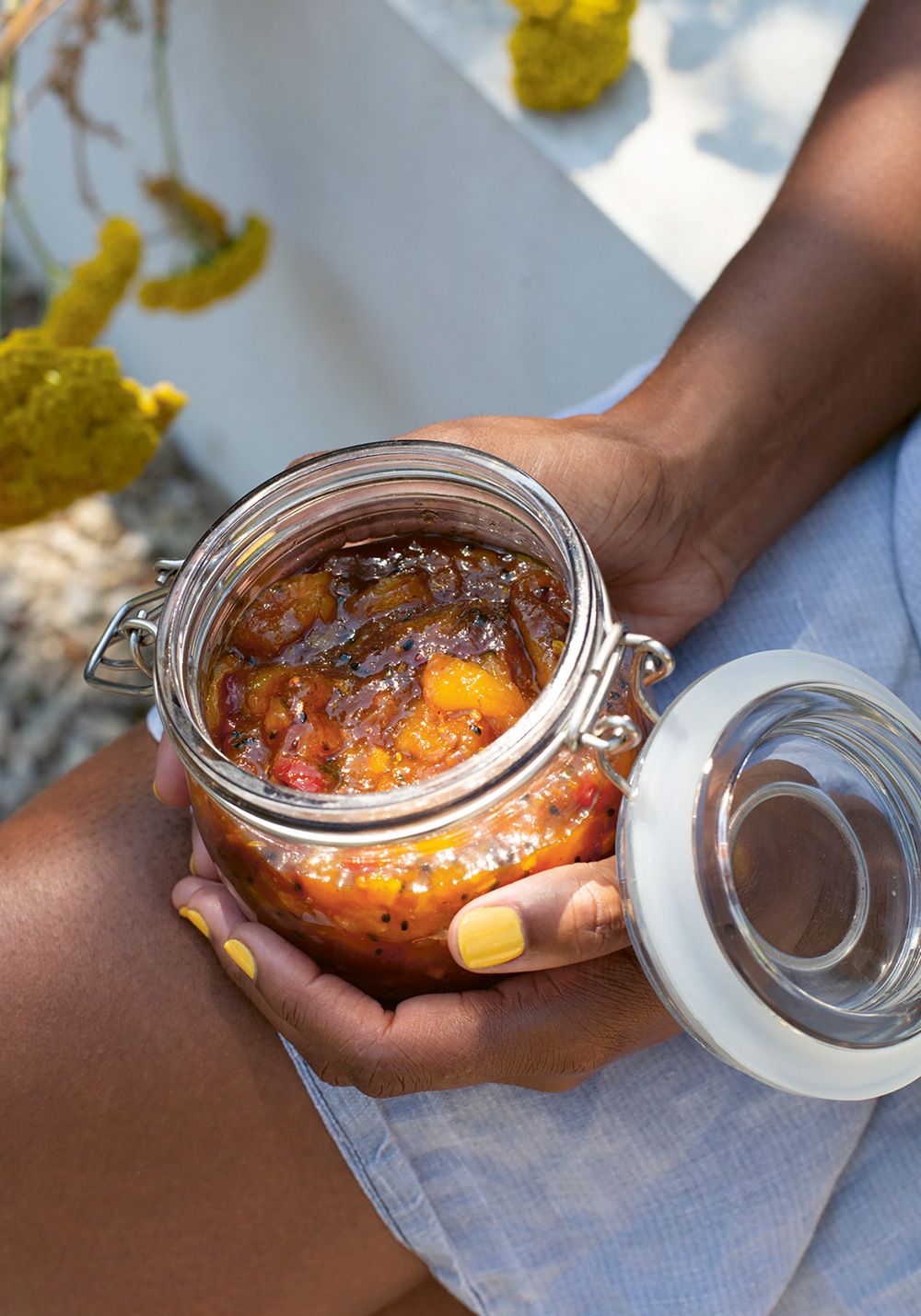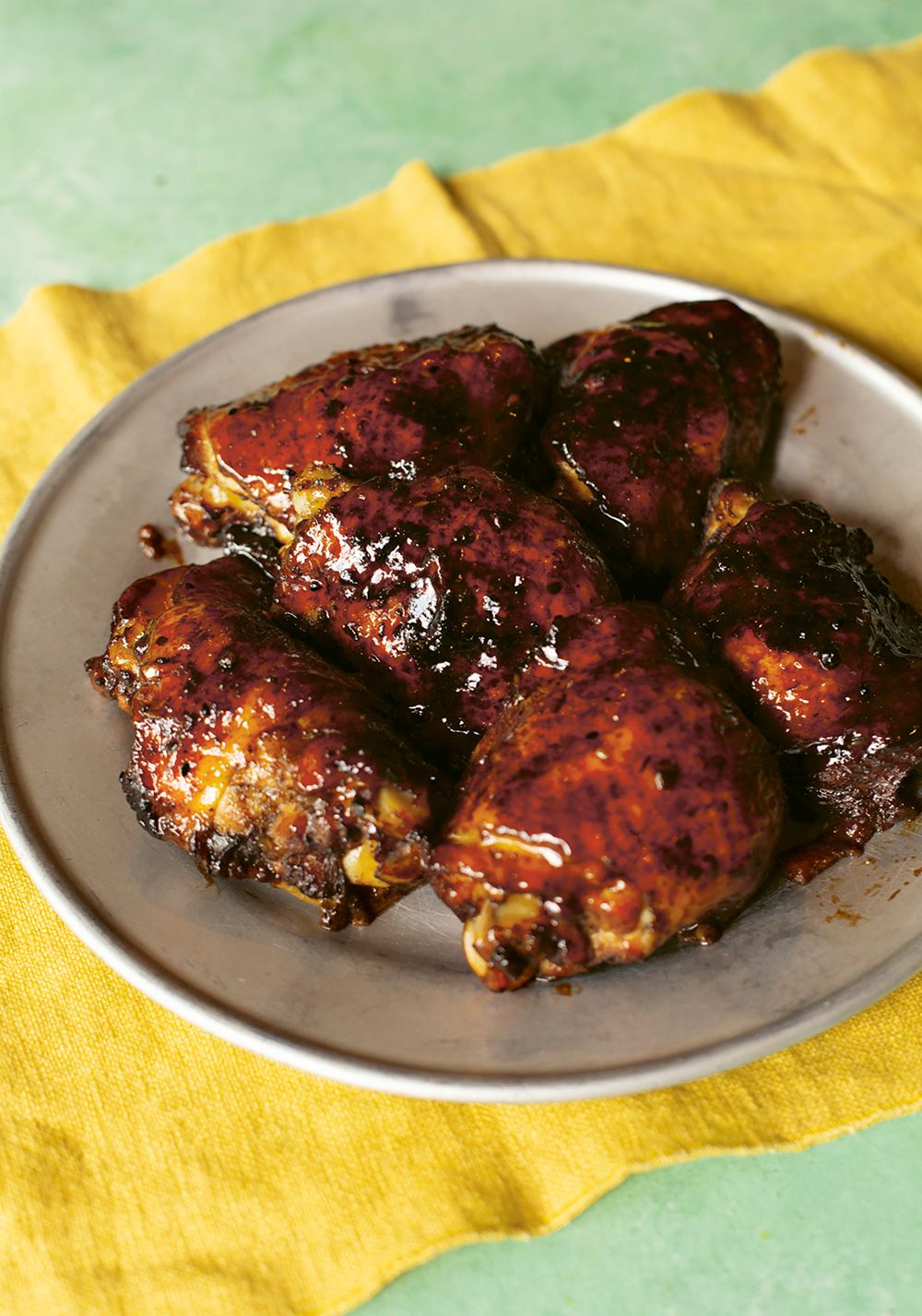Cook This: 3 Caribbean recipes from Kin, including sweet and sticky reef chicken

Our cookbook of the week is
by Marie Mitchell, a London-based chef, writer and co-founder of Island Social Club.
Jump to the recipes:
,
and
.
For chef Marie Mitchell, food is legacy. Archiving and cooking family recipes helped her navigate grief and loss. Nearly a decade ago, when Mitchell started a supper club with her Jamaican-born parents in London, England, food made her feel closer to her late brother, Richard. Years later, her cookbook debut, Kin (W. W. Norton & Company, 2025), took on new meaning with the death of her mother, Barbara.
When she launched her supper clubs — Pop’s Kitchen in 2016, a few months shy of her 30th birthday, and Island Social Club in 2017 — Mitchell says she felt a desire to understand who she was. She wanted to know the food of her Caribbean culture and heritage so she could recreate it and, eventually, pass it on to her children.
“Before that, my experience of it was literally just through family, not really having an identity individual of that,” says Mitchell. “The book was the accumulation of all the thoughts and feelings around it, and then being able to create this physical embodiment of those stories, and my own personal journey with it.”
Early in her supper clubs, Mitchell knew she wanted to write a cookbook. When she signed a two-book deal for Kin, “It felt like the perfect opportunity because I use food as my way of discovering culture and unearthing politics and history. Combining those curiosities and what I discovered — and what I will continue to because we’ll never know everything — felt like the most appropriate opportunity for me to marry the ways in which I like to explore culture.”
When she started cooking professionally, Mitchell says she felt the need to be “quite authentic.” As time has passed, she’s gained confidence in her ability to approach Caribbean food differently. Understanding the foundation and why certain dishes came to be allows her to stay grounded while moving forward.
Take Mitchell’s play on Jamaica’s national dish, ackee and saltfish. Instead of the traditional pairing of dumplings, she makes it into tarts. “It’s not this huge, massive shift, but it’s eating it in a way that I enjoy — that’s not necessarily how one would experience it normally,” she says. “That’s the thing that can feel exciting when thinking about how you innovate. But you’re honouring where that comes from and remaining close to that wheelhouse while bringing a part of yourself and your own experience into the work.”
The book’s 80 recipes are primarily Jamaican, with a few inspired by other parts of the Caribbean that Mitchell has loved visiting or learned about from friends, such as Cuba and Dominica (home to the following
). For the next book, she’ll focus on specific elements of Caribbean cuisine: “Kin was the start of the journey.”

Mitchell always wanted to discuss legacy in Kin because of the loss she’s experienced in her life, including her older brother, Richard, when she was 23. “There’s always been an understanding that death can be quite close by.” She believes that being detached from grief makes it harder to process. Talking about it can be a powerful remedy.
With her mother’s death, followed a few weeks later by the birth of Mitchell’s first child, Marcie, Kin’s focus shifted.
“I placed that conversation front and centre, whereas it might have been a bit more background,” says Mitchell. “Talking about grief, using my personal grief to talk about the wider framework of grief in the Caribbean that exists that we’ve not been allowed to maybe fully process because of the lack of accountability. And the fact that so much of what has been done to the Caribbean and continues to isn’t being owned up to.”
Mitchell sees the Ghanaian Sankofa bird on the book’s cover, moving forward while turning its head backward to grasp an egg in its beak, as embodying the Caribbean experience.
“It’s a powerful symbol for Black resistance and strength. And I suppose, because of the title of the book being about family and having half of my immediate family no longer being here, it felt appropriate to think about how my past — more recent and slightly further back — was informing what’s happening now in the present and my future. It also felt like the perfect symbol to think about the wider framework of the Caribbean. Everything that has happened, where we are now and where we continue to go.”
Nearing 40, Mitchell is excited for the next decade. Though she writes that working in food wasn’t the obvious choice, Mitchell now feels a new confidence. She appreciates the autonomy she’s achieved in her career and that food takes her to far-off places, physically or mentally, through the people she meets. “You get to go on their journeys with them. You get to explore places through the food they present to you. You get to understand a culture in a way that isn’t tangible. It’s an experience. It’s a feeling. It’s an emotion. That’s what food can do to you. It feels like a massive privilege to call this ‘work.’”
She wants people outside the culture to understand that Caribbean food isn’t all about chili heat. Plenty of dishes don’t feature hot peppers, and for those that do, cooks can adjust to their preference. “It’s about depth of flavour. It’s about vibrancy. It’s about richness in terms of that embeddedness that can come through from different dishes.”
Her goal with Kin was to communicate that Caribbean food “needs more love and respect,” adds Mitchell, laughing. Though some people immerse themselves in it, many often have a limited understanding.
“That’s why I’m on this journey. I feel like I don’t know enough about it. So selfishly, I’m doing this because I want to know more. I want to understand more, and then I get to share that with others. I want people to recognize that Caribbean cuisine can be cooked on a Monday, Tuesday, Thursday evening. It isn’t restricted to being only at barbecues in the summertime or only jerk, even though jerk is incredible, and I love it. But it’s more than (that).”
MANGO CHUTNEY WITH A TOUCH (OR MORE) OF SCOTCHIE

1 1/2 cups (360 mL) white wine vinegar
2 cups (400 g) granulated sugar
1 tsp cumin seeds
2 tsp coriander seeds
8 cloves
10 cardamom pods
1/4 tsp mild chili powder
1/2 tsp ground turmeric
2 tsp fine sea salt
6 firm mangoes, peeled, pitted and chopped into about 1/2-inch (1-cm) cubes
1 Scotch bonnet, seeded and finely chopped, or to taste
6 garlic cloves, roughly smashed
1 1/2 oz (40 g) ginger root, peeled and finely chopped
2 tsp nigella seeds (celery or black sesame seeds both work well as a sub)
Step 1
Pour the vinegar and sugar into a medium saucepan on medium-low heat and heat until the sugar has dissolved. Then, increase the heat and let it reduce until it becomes more syrupy — this should take no more than 6-8 minutes.
Step 2
Meanwhile, toast the cumin seeds, coriander seeds, cloves and cardamom pods in a dry frying pan on low heat, for 2-3 minutes, or until they are fragrant. Immediately remove the toasted spices from the heat and tip them into a mortar with the chili powder and ground turmeric. Remove the cardamom seeds from the pods and discard the pods, then use the pestle to grind the spices to your desired coarseness — a little bit of texture is fine. Alternatively, you can pulse the spices in a spice grinder, if you have one.
Step 3
Add all the spices to the vinegar syrup, along with the salt, mango, Scotch bonnet, garlic, ginger and nigella seeds. Cook for about 1 1/2 hours, or until your chutney is thick and syrupy. Transfer the hot chutney to sterilized jars, pop on the lids and let cool. Once cooled, the chutney can keep, unopened, for a couple of years.
REEF CHICKEN

Serves:
4
8 skin-on, bone-in chicken thighs
1 tsp fine sea salt
1/2 tsp ground black pepper
Packed 1/4 cup (50 g) molasses sugar or dark brown sugar
4 tbsp (60 mL) dark rum
2 tbsp (30 mL) lime juice
2 tsp white pepper
3/4 oz (25 g) ginger root, grated, or 1 tsp ground ginger
1 tsp ground cloves
1/2 tsp ground cinnamon
1/4 lemon, finely grated zest only
1 garlic clove, grated
3 tbsp Mango Chutney (
)
Flat-leaf parsley, leaves roughly chopped, to serve (optional)
Step 1
Place the chicken in a large bowl and massage the salt and black pepper into and under the skin. Set aside.
Step 2
In a mortar, mix together the molasses or brown sugar and 2 tablespoons of the rum, along with the lime juice, white pepper, ginger, cloves, cinnamon, lemon zest and garlic, pounding a little to make a paste. Massage this into the chicken, including under the skin, then cover the bowl and refrigerate for at least 1 hour, but no longer than 24 hours.
Step 3
About 30 minutes before you intend to cook, remove the meat from the fridge to bring it up to room temperature and preheat the oven to 400F (200C). Place the chicken, skin side up, in a shallow baking pan and bake it for 45 minutes, or until it reaches an internal temperature of 165F (74C).
Step 4
Meanwhile, in a bowl whisk together the mango chutney with the remaining rum until combined.
Step 5
Baste the skin of the cooked chicken with the rum-laced chutney, then return it to the oven for 3-4 minutes, until the chutney is warm. Or, if you want extra-crispy skin, heat your broiler to high and place the glazed chicken under the broiler, leaving it until the skin starts to caramelize. Serve sprinkled with roughly chopped parsley, if you wish.
SWEET TANGY COLESLAW

Serves:
4
1/4 small red cabbage
1/4 small white cabbage
1 red onion
1 large or 2 medium carrots
1/2 quantity of Sweet and Sour Dressing (
)
Fine sea salt and ground black pepper
Step 1
Finely shred both cabbages, thinly slice the onion and peel and julienne the carrot.
Step 2
Put them all in a mixing bowl and give them a good toss to evenly distribute the vegetables, then give your dressing a good shake or a whisk with a fork (it will separate while resting) and add it to the coleslaw. Give everything a good mix and make sure all your vegetables are coated. Season with salt and pepper to taste, then serve.
SWEET & SOUR DRESSING
2 tbsp white wine vinegar
2 1/2 tbsp lime juice (about 1 lime)
1/4 cup (60 mL) extra-virgin olive oil
2 tbsp honey, plus extra to taste, if needed
Fine sea salt and ground black pepper
Step 1
Pop all your ingredients in a jar, give them a good whisk with a fork, and season with salt and pepper to taste. Check for flavour, and add a little extra honey if you feel it’s too tart. The dressing will last for a couple of days in an airtight jar in the fridge (or you can freeze it).
Recipes and images excerpted from
by Marie Mitchell. Copyright ©2024 by Marie Mitchell. Used with permission of the publisher, W.W. Norton & Company, Inc. All rights reserved.
Our website is the place for the latest breaking news, exclusive scoops, longreads and provocative commentary. Please bookmark nationalpost.com and sign up for our cookbook and recipe newsletter, Cook This, here.



